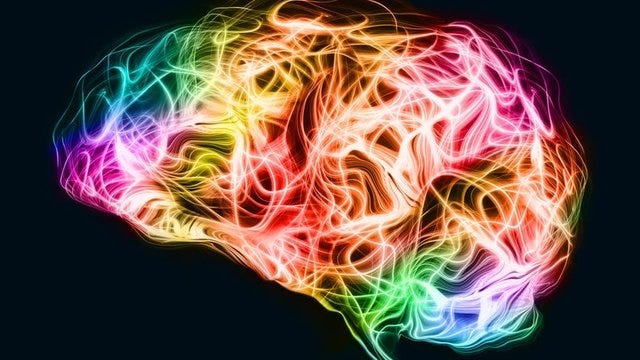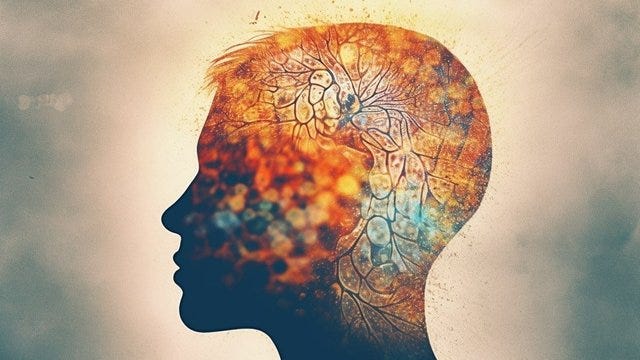Sci-Ed Update 276
Optical illusions, low iron, brain concepts, creative dementia, affirmative action, muscular dystrophy gene therapy, gaining weight back—and more!
Almost 40 per cent of US girls and young women have low iron levels

Nearly 40 per cent of girls and young women in the US have insufficient levels of iron in their blood, which can lead to symptoms such as fatigue, brain fog and hair loss. Of these, 16 per cent also have iron deficiency anaemia, a potentially serious condition in which a lack of iron leads to a reduction in red blood cells, which transport oxygen around the body.
Researchers have previously measured rates of iron deficiency and anaemia in high-risk populations, such as those with heavy menstrual bleeding. Studies looking into their prevalence in the US have also explored these conditions at a regional level.
To better understand their prevalence on a national scale, Angela Weyand at the University of Michigan and her colleagues analysed blood samples and demographic data from 3490 girls and women, aged 12 to 21, who took part in US-wide surveys between 2003 and 2020. No transgender people were included in the study.
They found that 39 per cent of the participants had iron deficiency, which they defined as having levels of ferritin – an iron-carrying protein – at less than 25 micrograms per litre. Of these, 16 per cent had anaemia, defined as haemoglobin levels below 120,000 micrograms per litre.
Read more→ AandP.info/zqb
Thinking New Thoughts about the Human Brain
In Episode 139, we explore a new discovery in nerve signaling in the brain called a dendritic action potential (dCaAP), we look at a wacky proposed model of brain function, and we share some ideas about how we can help our students understand the core concepts of chemical signaling and signal transduction in different contexts. Put on your thinking caps and jump into this fresh episode now.
To listen to this episode, click on the player (if present) or this link→ theAPprofessor.org/podcast-episode-139.html
Iron Deficiency’s Unseen Impact on Mental Health
Recent research emphasizes the role of iron, an often overlooked nutrient, in maintaining mental health. Researchers suggest iron deficiency could exacerbate mental health conditions such as depression and anxiety.
A low ferritin test result, indicating iron deficiency, calls for an increase in dietary iron and potentially supplements, under professional guidance. This revelation urges health providers and patients to consider nutritional aspects in mental health care.
Key Facts:
Iron, a critical nutrient for bodily function, is also essential for mental health; deficiencies can exacerbate symptoms of mental health conditions.
Ferritin tests, assessing the body’s iron storage, are recommended for individuals with mental health conditions, providing more accurate insight than standard iron or hemoglobin tests.
Supplementation of iron has shown improvements in mood and fatigue, even in those without full-blown iron-deficiency anemia, suggesting its potential as part of an integrated mental health treatment plan.
Read more→ AandP.info/cue
A Rare Form of Dementia Can Unleash Creativity

Neurological conditions can release a torrent of new creativity in a few people as if opening some mysterious floodgate. Auras of migraine and epilepsy may have influenced a long list of artists, including Pablo Picasso, Vincent van Gogh, Edvard Munch, Giorgio de Chirico, Claude Monet and Georges Seurat. Traumatic brain injury (TBI) can result in original thinking and newfound artistic drive. Emergent creativity is also a rare feature of Parkinson’s disease.
But this burst of creative ability is especially true of frontotemporal dementia (FTD). Although a few rare cases of FTD are linked to improvements in verbal creativity, such as greater poetic gifts and increased wordplay and punning, enhanced creativity in the visual arts is an especially notable feature of the condition. Fascinatingly, this burst of creativity indicates that the potential to create may rest dormant in some of us, only to be unleashed by a disease that also causes a loss of verbal abilities.
Read more→ AandP.info/luy
Why Scientists Must Stand for Affirmative Action and against Scientific Racism

Kevin Patton comment→ This is an interesting essay from Scientific American in October 2022, in anticipation of the recent Supreme Court decision on Affirmative Action in higher education.
Read more→ AandP.info/elb
Energy burn in muscle boosted by a hormonal signalling axis
Restricting dietary calories leads to weight loss, but with time these effects diminish because the body’s metabolism slows down. A hormone called GDF15 is now shown to maintain weight loss during dieting by promoting energy expenditure through the activation of pathways that affect calcium levels in skeletal muscle.
Read more→ AandP.info/um5
The first gene therapy for muscular dystrophy has been approved for some kids

The first gene therapy for children with Duchenne muscular dystrophy has been approved by the U.S. Food and Drug Administration. The therapy can be used in 4- and 5-year-olds with the degenerative muscle disease, the agency announced June 22.
Duchenne muscular dystrophy, the most common form of the muscle disease, is caused by mutations in the dystrophin gene, which normally makes a large protein that acts as a shock absorber to keep muscle cells intact.
Read more→ AandP.info/tzl
Optical Illusions: It's Not Actually Your Brain Getting Tricked
Printed circles that appear to move. Colors that seem different in spite of being identical. Everybody loves a good optical illusion, though precisely where the magic happens is still a mystery in many cases.
A new study by University of Exeter visual ecologist Jolyon Troscianko, and neuroscientist Daniel Osorio from the University of Sussex in the UK has weighed in on the debate over whether certain errors in sensing color, shade, and shape occur as a result of the eye's function or the brain's neurological wiring.
The pair found specific classes of illusion can be explained by limitations of our visual neurons – cells that process information coming in from the eyes – rather than higher-level processing.
Read more→ AandP.info/sud






